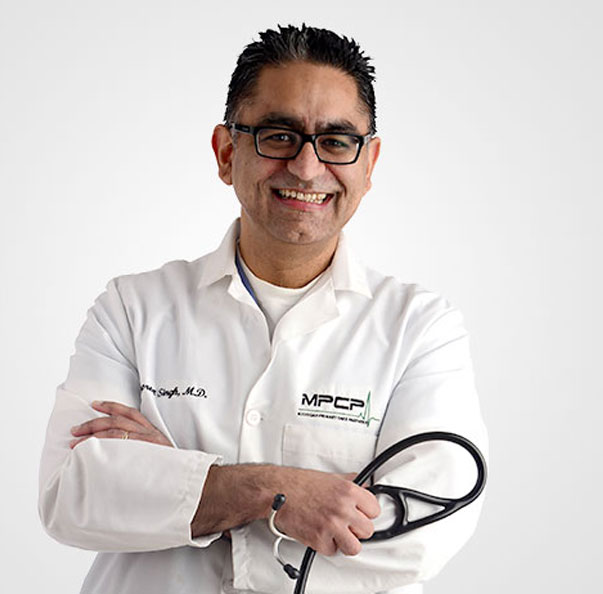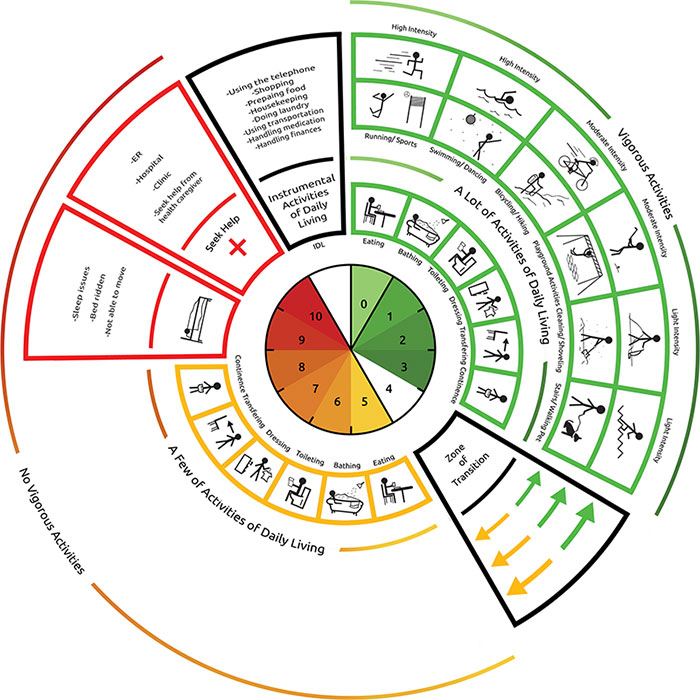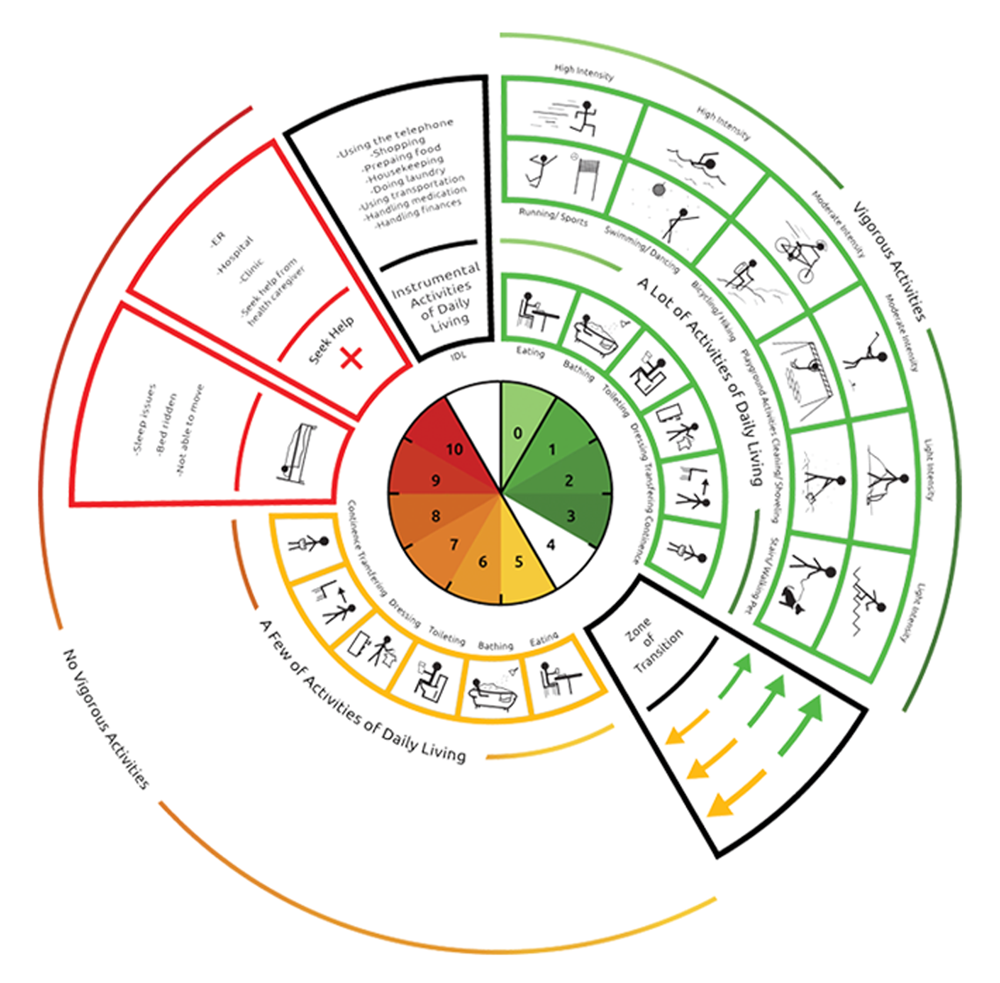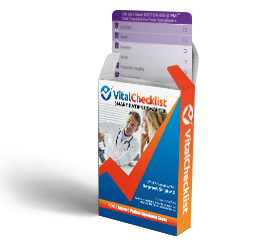Pain, not just a number!
What hurts you, may not hurt me.
A tool is needed to transform subjective pain symptoms to objective symptoms, as the pain assessment is the cornerstone to optimal pain management.
We have designed PainGrade, which adds functional status to the pain scale, thus helping patients and caregivers to come on the same page.
- PainGrade Level
- Vigorous Activities (VA's)
- Activities of Daily Living (ADL's)
- Sleep issues, bed ridden, or not able to move
- Seek help from the health caregiver
- 0
- High Intensity without pain VA's
- A lot of ADL without pain
- 1
- High Intensity VA's
- A lot of ADL's
- 2
- Moderate Intensity VA's
- A lot of ADL's
- 3
- Light Intensity VA's
- A lot of ADL's
- 4
- May be able to do light intensity VA's
- May be able to a lot of ADL's
- 5
- No VA's
- A few of ADL's (more number)
- 6
- No VA's
- A few of ADL's
- 7
- No VA's
- A few of ADL's
- 8
- No VA's
- A few of ADL's (less number)
- 9
- No VA's
- A few of ADL's (less number)
- Sleep issues, bed ridden, or not able to move
- 10
- No VA's
- A few of ADL's (very less number)
- Sleep issues, bed ridden, or not able to move
- Seek help from the health caregiver
Not validated by research. Seeking research partners. If interested to colloborate, please email us at drsingh@vitalchecklist.com
We will donate 5% of the profits from PainGrade to buy OPIOID CRISIS Toolkit
Read More
- Why should this PainGrade Vital Checklist be an integral part of healthcare? We want to educate patients with this PainGrade tool and make patients life easier. The prepared and empowered patient can present the symptoms in a better way and it will give a better differential diagnosis and thus order accurate tests. Health Caregivers will also benefit from this PainGrade as they can extract good history from the patients.
- Why is this Checklist free for patients?
Every patient is different and has different learning styles. When a patient in pain comes to a doctor, it is difficult for them to present their pain in a structured manner. A haphazard presentation may not provide an accurate history thus underdiagnosing the patient’s complaints or may lead to the wrong diagnosis. Patients should not be thinking of the answers when doctors are asking questions, they should be prepared with the responses from their home, and this is the reason we are providing this for free. We have adopted Khan’s Academy model of Flip the Classroom and would like to Flip the Healthcare by providing this PainGrade.com for free and accessible to the patients worldwide.
In the opioid's era crisis, we want to provide the one tool for the health caregivers and the patients so they can be on the same page. We want to start this movement from the grassroots level and want to involve all the medical professionals. We invite medical students and other health caregivers to contribute and translate this PainGrade in their native language. - How can we make patients smarter? Please share this PainGrade Vital Checklist with your friends and family and help to spread PainGrade.com throughout the globe.
-
This PainGrade is inspired by:
-
Neil Fleming — a famous research scientist from New Zealand, developed VARK-Learning theory and showed that people learn differently. He explains different learning styles with the acronym VARK which stands for Visual, Auditory, Reading/Writing, and Kinesthetic. Neil Fleming’s VARK Theory inspired me to not only use checklists but to also incorporate two-dimensional pictures for my patients which has increased my patient experience score.
-
Dr. Atul Gawande — published a research article in NEJM and wrote a book –- The Checklist Manifesto which showed a decrease in complications by an average of 35% and mortality by 47% after implementing checklists.
-
Dr. Peter Pronovost — Keystone Initiative published in NEJM showed infections decreased by 61% and saved 1,500 lives as well as $100 million in healthcare costs by incorporating a central venous catheter checklist.
-
Captain Chesley "Sully" Sullenberger — accomplished the Hudson Miracle by landing his plane on the Hudson River with the help of a checklist, saving 155 lives.
-
Dr. Barbara Oakley — explained critical concepts of chunking in Learning How to Learn Course and using her theory, I have chunked Pain Grade Vital Checklist for easy memorization. This PainGrade Portal can integrate with electronic health records and help make the healthcare leaner.
-
Mark Graban and Jeffrey Liker— Taking a cue from their books Lean Hospitals and The Toyota Way respectively, we have developed PainGrade and Vital Checklist flash cards and posters to be used at the patient bedside for easier Teach-Back, prevent waste, decrease healthcare spending and to optimize health caregiver time spent with patients.
-
At last, I want to thank my dad—Anar Singh who taught me the values of leaving a legacy for the world. I still remember September 19th, 1992, eleven days before his death, when he showed me the principle of work ethics. His words still echo in my ears, “work with such a passion and commitment that even if you are sitting in a cave, people come looking for you.”
 Problem
Problem
- Pain assessment is subjective. 5/10 pain for one patient is not the same for the other patient.
- Asking about pain intensity from 0 to 10 and 10 being the worse does not generate EMPATHY
- Underdiagnosis of pain makes patients’ suffering worse
- Overdiagnosis of pain, still makes patients’ life difficult as this may lead to addiction
- Overdiagnosis leads to overprescription and misprescription of opioids
- Overprescription results into Narcotic overdose and abuse
- Opioid Crisis, morbidity and mortality due to narcotics is on the rise
- Poor pain assessment results in unnecessary testing, thereby, increasing health care spendings
 Solutions
Solutions
- Pain intensity on numeric pain rating scale and assessing functional status of the patient helps the health caregivers to generate empathy.
- Activities of daily living + Vigorous activities = Functional Status
- Functional Status + Pain Intensity= Empathy for the patient
- Empathy for the patient + Health caregivers asking more questions using Vital Checklist “Life isn’t Good, D.O.C.T.O.R Aid @ PM”= Better Patient Experience and Patient Engagement
- Precise pain assessment saves patient lives and healthcare dollars. Accurate pain assessment helps health caregivers to order tests correctly.
- May prevent narcotic overdose
- Patients may prefer alternative therapies
 Action
Action
- Let’s participate in the research and help many more patients


About Dr. Harpreet Singh MD
- Internal Medicine Physician – MPCP
- Chief Experience Officer – MPCP
- Chief Medical Author – Vital Checklist; Road to USMLE Step 2 Clinical Skills, Vital Checklist Cardiology; (iCrush) Ebola
- Communication & Clinical Skills Coach
- Speaker
- Inventor of Patient Education Tool- PainGrade.com, iCrushDiabetes.com
- Radio Show Host of Talk Medicine on WBRN
- Patient Experience Coach
- USMLE Step 2 Clinical Skills trainer
- Health and Wellness Patient Education
- Medical Expert
- Voracious Reader of Medical Journals & Business Books
The Five Why’s of Vital Checklist
-
Why should patients use Vital Checklist?
- Health caregivers spend years/decades in getting trained in their field while patients have 15 minutes to ask questions. The Internet is an excellent tool as a symptom checker but to be on the same page; patients need symptom checklist to discuss their history and recognize disease patterns.
-
Why health caregivers and patients should be on the same page? Why should health caregivers use Vital Checklist?
- Improved communication and improved documentation.
-
Why is it essential to document and communicate effectively?
- Reimbursement by ICD-10 requires asking more questions and documentation.
- Communication is the fundamental tenet which is measured by Patient Experience Score
-
Why is Patient Experience (PE) Score vital for a health caregiver and healthcare facility?
- PE improves job satisfaction decreases stress and promotes health and wellness of the health caregivers.
- PE improves the credibility of the health care facility and health caregivers.
- PE improves reimbursement
-
Why is it essential to pay attention to job satisfaction of healthcare employees, credibility, crisp documentation, proactive communication, improved patient experience score?
- Reduce malpractice lawsuits
- Decrease burnout amongst health caregivers
Invite Dr. Singh for Seminars & Workshop
ContactDr. Harpreet Singh MD Reviews
What patients are saying about Dr. Singh?
Invite Dr. Singh to speak to your organization. Email at drsingh@vitalchecklist.com
Life isn’t Good DOCTOR AID @ PM
The Vital Checklist Way
- Where is your pain located?
- Can you point to where your pain is?
- Can you grade your pain on a scale of 0 to 10?
- How long have you experienced this pain?
- When did your pain start?
- Did it start all of a sudden or did it develop, slowly over a period of time?
- Can you describe your pain?
- Any variation in pain in morning or evening?
- What were you doing when the pain started?
- Does your pain stay there or does it travel anywhere else?
- Any other symptoms associated with this pain?
- What makes your pain worse?
- What makes pain better?
- Any similar episode of pain in the past?
- Any medications that helped you with the pain in the past?
vkidh nnZ dh txg crk ldrs gSa\
vki nnZ ds xzsM dks 1 ls 10 ij crk ldrs gSa\
vkidk nnZ dc ls gS\
vkidk nnZ dc izkjEHk gqvk\
;s nnZ vpkud ;k /khjs&/khjs 'kq: gqvk\
vvki vius nnZ dk o.kZu dj ldrs gSa\
D;k vkids nnZ esa izfrfnu cnyko gS\
vki D;k dj jgs Fks tc nnZ 'kq: gqvk\
D;k nnZ dgha Hkh fodh.kZ djrk gS\
dksbZ vU; y{k.k gS\
D;k bls cnrj cuk nsrk gS\
D;k bls cgrj cuk nsrk gS\
vrhr esa fdlh Hkh blh rjg dk nnZ gqvk gS\
vkidks dkSu lh nokvksa us enn dh\
quhwnMU drd ik`Qy hY ?
10 iv`co Awpxy drd nMU qusI ikMny nMbr dvogy ?
quhwnMU drd ikMny smyN qoN hY ?
quhwfw drd kdoN SurU hoieAw?
kI quhwfw drd ie`k dm jW hOlI-hOlI SurU hoieAw hY ?
Awpxy drd bwry ivsqwr ‘c d`so
kI quhwfy drd iv`c idn-rwq dw Prk hY ?
drd SurU hox dy smyN qy qusI kI kr rhy sI ?
kI quhwfw drd ie`k QW itikAw rihMdw hY jW iksy pwsy PYldw hY ?
koeI hor sMbMiDq l`Cx ?
quhwfw drd kihVAW kwrnW krky v`Ddw hY ?
quhwfw drd bihqr ikvyN huMdw hY ?
kI quhwnMU ies qrHW bIqy smyN iv`c vI kdy mihsUs hoieAw sI ?
vkoeI AijhI dvweI ijs ny quhwnMU bIqy smyN iv`c drd qoN Arwm id`qw hovy ?
మీ నొప్పి ఎక్కడ ఉందో చూపించగలరా?
ఒకటి నుంచి పది అనే కొలత ప్రమాణం పై మీ నొప్పి ఎంత ఉందో చెప్పగలరా?
ఎంత కాలం నుండి మీకు ఈ నొప్పి ఉంది?
ఇది ఎపుడు ప్రారంభం అయ్యింది? ఆకస్మాత్తుగా
మొదలైందా లేదా క్రమేపి ఆరంభం అయిందా?
మీ నొప్పిని వివరించగలరా?
ఊదయం సాయంత్రం సమయాల్లో నొప్పిలో ఏమైనా తేడా ఉందా?
నొప్పి మొదలైనప్పుడు మీరు ఏం చేస్తున్నారు?
నొప్పి ఒకే చోట ఉంటుందా లేదా ఇతర ప్రాంతాలకు వ్యాపిస్తుందా?
ఇంకా ఏమైనా లక్షణాలు ఉన్నాయా?
ఆ బాధను అధికం చేయడానికి తోడ్పాటు అందించే కారకాలు ఏమైనా ఉన్నాయా?
ఏం చేస్తే బాగుంటుంది?
గతంలో ఇలాంటి సంఘటనలు జరిగాయా?
గతంలో నొప్పి తగ్గించడానికి ఏమైనా మందులు ఉపయోగపడ్డాయా?
آپ کو درد کہاں ہے؟
کیا آپ درد والے حصے کی نشاند ہی کر سکتے ہیں؟
کیا آپ اپنی درد کی شدت بتا سکتے ہیں؟
درد کب سےہو رہا ہے؟
درد کب شروع ہوا؟
کیا یہ اچانک شروع ہوایاں وقت کے ساتھ آہستہ آہستہ بڑھا؟
کیا آپ اپنی تکلیف واضح کر سکتے ہیں؟
صبح یاں شام میں درد میں کوئی خاص تبدیلی؟
جب درد شروع ہوا تب آپ کیا کر رہے تھے؟
کیا آپ کو درد ایک جگہ ہوتا ہےیاں یہ آگے پیچھے بھی جاتا ہے؟
کیا آپ کو درد کے ساتھ اور کوئی تکلیف ہوتی ہے؟
کیا چیز درد کو بڑھا تی ہے؟
کس چیز سے درد میں کمی آتی ہے؟
پہلے کبھی ایسا درد ہوا ؟
کوئی دوا ئی جس کے پہلےلینے سےدرد کم ہوا ہو؟
Можете ли Вы указать, где ваша боль?
Можете ли Вы оценить интевсиноcть болью от 1 до 10?
1 = Минимальная интенсивность
10 = Максимальная интенсивность
Как долго это продолжается?
Когда это началось?
Можете ли Вы подробно рассказать о боли ?
Это началось внезапно или медленно?
Изменение боли утром или вечером?
Чем Вы занимались когда начинается боль?
Боль находится там где началась или иррадирует куда-нибудь ?
Есть другие симптомы связанные с болью ?
Что усиливает боль?
Что уменьшает боль?
Была ли у Вас подобная боль раньше?
Лекарства, которые помогают Вам с болью?
Você pode apontar onde dói?
Você pode avaliar a intensidade da sua dor entre 1 e 10?
Há quanto tempo sente isso?
Quando começou?
Você pode descrever sua dor?
A dor começou subitamente ou foi aos poucos?
Alguma mudança nos sintomas durante o dia, tarde ou à noite?
O que você estava fazendo quando a dor começou?
A dor se espalha ou irradia para outro lugar?
Existe algum outro sintoma associado?
O que faz a dor piorar?
O que melhora a dor?
Algum episódio semelhante no passado?
Alguma medicação aliviou sua dor no passado?
നിങ്ങൾക്കു എവിടെയാണ് വേദന?
നിങ്ങളുടെ വേദനയുടെ തീവ്രതയെ 1-10 വരെ ഉള്ള ഒരു സ്കെയിലിൽ തരം തിരിക്കാമോ?
എത്രനാളായി വേദന ഉണ്ട്?
തുടക്കം വിവരിക്കാമോ?
വേദനയുടെ സവിശേഷതകൾ എന്തെല്ലാം?
എപ്പോഴാണ് വേദന കൂടുതൽ?
പകലോ രാത്രിയിലോ വേദനയിൽ വ്യത്യാസം തോന്നുന്നുണ്ടോ?
വേദന തുടങ്ങിയപ്പോൾ നിങ്ങൾ എന്ത് ചെയ്യുകയായിരുന്നു?
വേദന മറ്റെവിടേക്കെങ്കിലും വ്യാപിക്കുന്നുണ്ടോ?
ഇതിനോട് അനുബന്ധിച്ചു വേറെ പ്രശ്നങ്ങൾ ഉണ്ടോ?
വേദന അധികരിപ്പിക്കുന്നതു എന്തെല്ലാം?
വേദന കുറയ്ക്കുന്നതു എന്തെല്ലാം?
മുൻപ് ഇതുപോലെ ഉണ്ടായിട്ടുണ്ടോ?
വേദന സംഹാരികൾ ഉപയോഗിക്കുന്നുണ്ടോ?
خبرني بمكان الألم؟
هل يمكنك أن تشير الى مكان الألم بالضبط
هل تستطيع ان تقيم مستوى الالم على مقياس ١-١٠؟
منذ متى و انت تعاني من هذا الألم؟
തുمتى بدأ عندك هذا الألم؟
هل بدء الالم بصورة مفاجئة ام تدريجية؟
هل تستطيع ان تصف لي الألم الذي تحس به؟
هل هناك أي تفاوت في الألم مابين النهار و المساء؟
ما الذي كنت تفعله عندما بدأ عندك هذا الألم؟
هل الالم باقي في مكان واحد ام انك تحس بالالم ينتشر الى اماكن اخرى؟
هل هناك اية اعراض اخرى مصاحبة للألم؟
ما الذي يزيد من حدة الالم؟
ما الذي يساعد على التخفيف من حدة الالم؟
هل عانيت من الآلام مشابهة في الماضي؟
هل استخدمت اية ادوية للمساعدة على تخفيف حدة الالم في السابق؟
- ನಿಮಗೆ ನೋವು ಎಲ್ಲಿದೆ?
- ನಿಮ್ಮ ನೋವು ಎಲ್ಲಿದೆ ಎಂದು ನೀವು ಸೂಚಿಸಬಹುದೇ?
- ಪ್ರಮಾಣದಲ್ಲಿ ನಿಮ್ಮ ನೋವನ್ನು ನೀವು ತಿಳಿಯಬಲ್ಲಿರಾ?
- ನೀವು ಎಷ್ಟು ಸಮಯದಿಂದ ನೋವಿನಿಂದ ಬಳಲುತ್ತಿರುವಿರಿ?
- ನಿಮಗಾಗಿ ನೋವು ಯಾವಾಗ ಆರಂಭವಾಯಿತು?
- ನೋವು ಇದ್ದಕ್ಕಿದ್ದಂತೆ ಪ್ರಾರಂಭವಾಗಿದೆಯೆ ಅಥವಾ ಸಮಯದ ಅವಧಿಯಲ್ಲಿ ಅದು ಅಭಿವೃದ್ಧಿ ಹೊಂದಿದೆಯೇ?
- ನಿಮ್ಮ ನೋವನ್ನು ನೀವು ವಿವರಿಸಬಹುದೆ?
- ನಿಮ ನೋವಿಗೆ ಯಾವುದೇ ದೈನಿಕ ವ್ಯತ್ಯಾಸವಿದೆಯೇ?
- ನೋವು ಪ್ರಾರಂಭವಾದಾಗ ನೀವು ಏನು ಮಾಡುತ್ತಿದ್ದೀರಿ?
- ನೋವು ಅದರ ಸ್ಥಳದಲ್ಲಿ ಸ್ಥಿರವಾಗಿದೆಯೇ?
- ನೋವುಗೆ ಸಂಬಂಧಿಸಿದ ಯಾವುದೇ ರೋಗಲಕ್ಷಣಗಳನ್ನು ನೀವು ಹೊಂದಿದ್ದೀರಾ?
- ಏನು ನಿಮ್ಮ ನೋವು ಹೆಚ್ಚಿಸುತ್ತದೆ
- ನಿಮ ನೋವುಎನು ಏನು ಕಡಿಮೆ ಮಾಡುತ್ತದೆ?
- ನೀವು ಹಿಂದೆ ನೋವು ಹೊಂದಿದ್ದೀರಾ?
- ನೋವು ಬಂದಾಗ ನೀವು ಏನು ಔಷಧಿಯನ್ನು ತೆಗೆದುಕೊಳ್ಳುತ್ತೀರಿ?
ík{ku Lku [ku¬Mk heíku õÞkt Ëw¾kðku ÚkkÞ Au íku çkíkkðku
ík{ku Lku 1 Úke 10 Lkk «{ký{kt fux÷ku Ëw¾kðku ÚkkÞ íku çkLkkðe þfku ?
fux÷k Mk{ÞÚke Ëw¾kðku ÚkkÞ Au ?u
õÞkhÚke Ëw¾kðkLke þYykík ÚkE ?
ík{u Ëw¾kðk rð»ku ðÄw rðøkíkðkh sýkðe þfku Aku ?
íkuLke þYykík yufkyuf ÚkE fu Äe{u Äe{u ?
Mkðkh Mkkts ík{khk Ëw¾kðk{kt fkuE VuhVkh ?
ftR «ð]r¥k{kt Mktf¤kÞu÷k nkuÞ íÞkhu Ëw¾kðku ÚkkÞ Au ?
Ëw¾kðku yuf s søÞkyu Au fu þhehLkk yLÞ ¼køk{kt Ãký «Mkhu Au ?
çkeò yLÞ ÷ûkýku ?
fkuLkkÚke íku{kt ðÄw økt¼eh ÚkkÞ Au ?
fkuLkkÚke Ëw¾kðk{kt hkník ÷køku Au ?
¼qíkfk¤{kt ykðwt fkuE ð¾ík ÚkÞu÷wt ?
fkuE ËðkÚke ¼qíkfk¤{k Ëw¾kðk{kt hkník ÚkÞu÷e ?t
- Puedes apuntar donde te duele?
- Del 1 al 10, cual es la intensidad del dolor?
- Desde cuando sientes esto?
- Cuando empezo?
- Puedes describir tu dolor?
- Los síntomas surgieron subitamente o surgieron de forma gradual?
- Algun cambio en los síntomas durante el día, tarde o noche?
- Que estabas haciedo cuando empezo el dolor?
- El dolor es localizado o se mueve para otro lugar?
- Existe otro síntoma asociado?
- Existe algo que empeore el dolor?
- Existe algo que alivie el dolor?
- Algun episodio similar en el pasado?
- Alguna medicina alivio tu dolor en el pasado?
உங்களுக்கு எந்த இடத்தில் வலி உள்ளது என்று சுட்டிக்காட்ட முடியுமா?
உங்கள் வலியின் அளவை கீழ்வரும் அளவுகோலில் (1 to 10) வகைப்படுத்த முடியுமா?
இந்த வலி எவ்வளவு நாளாக இருந்து கொண்டிருக்கிறது?
எப்போது ஆரம்பித்தது?
வலியின் அறிகுறியை விளக்கமாக கூறவும்
எந்த நேரத்தில் இதை கவனித்தீர்கள்?
காலை, மாலை, இரவு வலியின் அறிகுறிகள் மாறுகிறதா?
நீங்கள் என்ன செய்து கொண்டிருக்கும் போது இந்த வலி வந்தது?
இந்த வலி வேறு இடங்களுக்கு பரவுகிறதா?
வேறு இணைந்த அறிகுறிகள் மற்றும் பிரச்சனைகள் இருக்கிறதா?
எது வலியை மோசமாக்குகிறது?
எது வலியை குறைக்கிறது?
இதற்கு முன் இந்த வலி வந்துள்ளதா?
இதற்குமுன் வலிக்காக மருந்து சாப்பிட்டதால் ஏதேனும் பலன் ஏற்பட்டதா?
Reference
- Marcus, G.M., et al., The utility of gestures in patients with chest discomfort. Am J Med, 2007. 120(1): p. 83-9.
- Davies, H.A., et al., Angina-like esophageal pain: differentiation from cardiac pain by history. J Clin Gastroenterol, 1985. 7(6): p. 477-81.
- Swap, C.J. and J.T. Nagurney, Value and limitations of chest pain history in the evaluation of patients with suspected acute coronary syndromes. Jama, 2005. 294(20): p. 2623-9.
- Fu, L.W., Z.L. Guo, and J.C. Longhurst, Undiscovered role of endogenous thromboxane A2 in activation of cardiac sympathetic afferents during ischaemia. J Physiol, 2008. 586(13): p. 3287-300.
- Lee, T.H., et al., Acute chest pain in the emergency room. Identification and examination of low-risk patients. Arch Intern Med, 1985. 145(1): p. 65-9.
- Berger, J.P., et al., Right arm involvement and pain extension can help to differentiate coronary diseases from chest pain of other origin: a prospective emergency ward study of 278 consecutive patients admitted for chest pain. J Intern Med, 1990. 227(3): p. 165-72.
- Kreiner, M., et al., Craniofacial pain as the sole symptom of cardiac ischemia: a prospective multicenter study. J Am Dent Assoc, 2007. 138(1): p. 74-9.
- Chan, S., et al., The use of gastrointestinal cocktail for differentiating gastro-oesophageal reflux disease and acute coronary syndrome in the emergency setting: a systematic review. Heart Lung Circ, 2014. 23(10): p. 913-23.
- Henrikson, C.A., et al., Chest pain relief by nitroglycerin does not predict active coronary artery disease. Ann Intern Med, 2003. 139(12): p. 979-86.
- Mason, L., et al., Systematic review of topical capsaicin for the treatment of chronic pain. Bmj, 2004. 328(7446): p. 991.
Download the free PainGrade Vital Checklist
Lean Patient Experience Certification Course
We have developed various modules for the health caregivers.
iCrush DiabetesPainGrade
Contact
To do a research project, submit any correction, contribute, join our team, advertise and co-brand with us or have a question! Ask us.
I started my medical career in 1995 when I joined KMC, Manipal, one of the prestigious institutions in India. KMC, Manipal is in Karnataka,and people speak Kannada and Tulu. I remember the lecture in medical school when our professor explained the importance of integrating communication skills with the clinical skills. He emphasized the need to learn the local language. India is a diverse country with many languages and dialects. Our professor asked us a straightforward question, if we cannot understand the patient’s pain, then how will we treat it. He explainedthe difference between a symptom and a sign and made a funny acronym to describe the characteristics of both. Read More...
The checklists, text, graphics, images, videos and other material contained in the videos and PainGrade Vital Checklist Website ("Content") are for informational purposes only. The Content is not intended to be a substitute for professional medical advice, diagnosis, or treatment. Always seek the advice of your physician or another qualified health provider with any questions you may have regarding a medical condition. Never disregard professional medical advice or delay in seeking it because of something you have read or heard on the PainGrade Vital Checklist website, its videos or other concepts.
In accordance to the HIPAA regulation, a duly informed consent was taken from the real-life patients, students, caregivers or other individuals appearing in the informational videos presented on this website.
If you think you may have a medical emergency, call your doctor or 911 immediately. Vital Checklist website and videos do not recommend or endorse any specific tests, physicians, products, procedures, opinions, or other information that may be mentioned on the Site. Reliance on any information provided by PainGrade Vital Checklist website/videos, Vital Checklist employees, others appearing on the Site at the invitation of Vital Checklist, or other visitors to the Site is solely at your own risk.
The Site may contain health or medical-related materials that are sexually explicit. If you find these materials offensive, you may not want to use our Site. The Site and the Content are provided on an "as is" basis.







